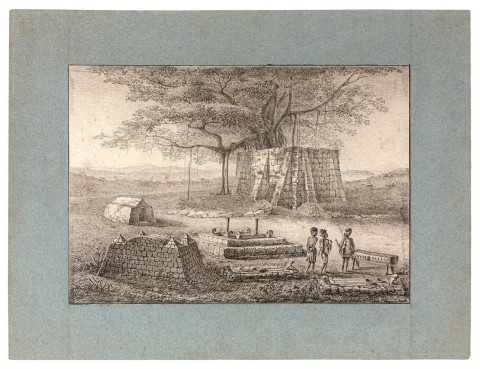(A SCENE IN THE CEMETERY IN THE HILLS BEHIND KUPANG), August – November 1801
CHARLES-ALEXANDRE LESUEUR
pen, ink and graphite on laid paper
a framing mount of blue-grey paper applied over the paper sheet
152 x 214 mm (image)
222 x 290 mm (sheet)
This view was not included in the first edition atlas of 1807 but was added by Freycinet in the second edition of 1824 as plate 51. The finished engraving was noted as C.A. Lesueur delint., J. Devilliers aqua forti, A. Delvaux sculpt.
See also a couple of pencil studies reproduced in Baglione, G., and Crémière, C., Charles-Alexandre Lesueur, and noted as Le Havre nos. B:17042 & 17045
A beautifully-executed view of the main cemetery in Kupang, with three Malay men in the foreground, standing among a group of some of the more remarkable local tombs. The French fort, with a flag flying, is shown in the distance towards the left, and in fine detail the distant Géographe, in the bay beyond the fort, is shown with a plume of smoke, presumably in the midst of firing a salute.
This scene was not published until the second edition of Baudin’s voyage in 1824, where it was given the very descriptive caption “Île Timor. Vue d’un Cimetière Malais, d’une partie de la Baie et de la ville de Coupang, de l’Île de Simao et de l’Île de Kéra” (plate 51).
As the long caption confirms, and indeed as the scene itself makes perfectly clear, this view is taken from the main cemetery overlooking the port of Kupang: the centre of town and the flagstaff at the fort can be seen in the background, while the single ship in the roadstead is assumed to be the Géographe, prior to the arrival of the Naturaliste, later in 1801.
The burials shown in the foreground of the cemetery were of more than academic interest because, sadly, there were deaths among Baudin’s crew, and the presumption is that they would have been buried either here in this main cemetery or nearby. These tombs however are clearly Timorese rather than the rougher burials of the expedition. On the other hand, while the shape of the expedition’s fort is well-defined, in front we can see several protuberances which might be rocks, or plausibly the expeditioners’ graves.
The most senior of Baudin’s men to die was Anselme Riedlé, after an agonising illness, on 21 October 1801. His loss was greatly felt, and the decision was taken to bury him in some state, his coffin carried by four local soldiers and accompanied by a great cortège of officers, savants and local dignitaries.
Apparently at the behest of Péron himself, as a botanist Riedlé was interred alongside the plot of Bligh’s old colleague, the gardener David Nelson, who had died in Kupang after the long-boat voyage in the wake of the Bounty mutiny. Their grave was marked with a “rough” stone. The smoke emanating from the ship would be from a cannon pointing towards the fort. Could this even have been a salute accompanying the burial of Riedlé?
An interest in funerary traditions was not unique to the Baudin voyage, as many early modern voyagers not unreasonably saw the burial of the dead as a way of understanding different societies. In Timor, Lesueur also did a companion scene of the Chinese cemetery in Kupang which overlooked the harbour from further to the east (plate 52) and also some detailed depictions of individual Chinese tombs (plate 53).
If we are right in speculating that the burial of Riedlé was indeed taking place near the fort, the comparison between the local tombs and the simple French interment would have been of poignant interest to Lesueur.
